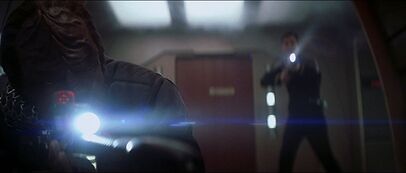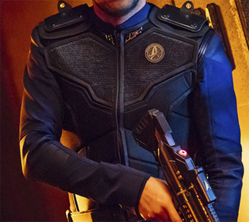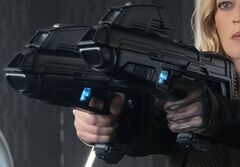Hazard Team
More actions
A Hazardous Situation Response Team, more commonly referred to as a Hazard Team, is a special unit stationed aboard many Starfleet vessels, intended for use on away missions and other situations where heavy combat is anticipated. Drawn from a starship or starbase's personnel, these crewmembers take on additional duties of elite training and hazardous missions to step up when they are needed. Despite this combat training and mission profile, Hazard Teams bring a wide range of technical, medical, and scientific skills to any operation, providing more versatility than a simple security team.
History
For centuries, Starfleet vessels dispatched their senior staff at the front of all major operations and away teams. This was by design, as many starships encountered highly unpredictable situations and undertook missions that could have profound Prime Directive and political ramifications. In fulfilling its mandate of diplomacy and exploration, Starfleet deemed it necessary that seasoned and qualified officers were positioned to make these immediate and urgent decisions.
By the 2360s, it was no longer common for starship captains to regularly take on away missions themselves, as regulations changed to learn from the many situations in which this put the ship’s senior-most officer in unacceptable levels of danger. This was underscored by the limited but fierce ground combat Starfleet engaged in with the Cardassians in the late 2350s. Up until the Dominion War, the standard composition of most standard away teams included a vessel’s first and second officers, and often other senior specialists such as the ship’s counsellor or medical officer. While the war itself did not immediately change this, the conflict made the disadvantages of sending senior officers (many of whom had very little experience of warfare) even more evident.
The Dominion War

Starfleet had not engaged in a full-scale war since the 2250s, and the sudden shift to a war footing against the Dominion left the majority of the fleet’s ships thrust into combat despite many crews only having been trained in basic personal defense. Onboard training began with varying degrees of intensity and with different techniques as each crew made personal adaptations. This increased starships’ numbers of combat-ready personnel in case of boarding or ground action. However, the crew members most capable of handling dangerous away missions were still most often security officers, who usually lacked the training to handle specialized engineering or scientific tasks. With increasing casualty rates, many captains simply couldn’t afford to risk their senior officers on the most dangerous assignments, especially when they were just as likely to need their talents on the bridge.
As a result, many captains developed hybrid teams with engineers or scientists trained in combat and embedded with security officers to provide versatile response forces. In larger operations, these specialized teams were able to set up beachheads or perform reconnaissance. For ships not assigned to these sorts of assaults, the teams were useful to take the place of standard away teams when the safety of a location was in doubt.
While this was only a temporary war-time measure and never formally implemented or standardized across the fleet, many captains unofficially shared their experiences and techniques for training and equipping these teams. There was also broad agreement that these expanded security teams were more effective on missions with non-combat priority objectives or challenges. The units benefited from the expanded skillsets of their members, while their continued joint training made them better-prepared in quick-changing situations than common away teams of junior officers with little collective experience. Teams who had been together for many missions also demonstrated superior unit cohesion to ad-hoc away teams.
Implementation
These lessons lay dormant for some years after the Dominion War, with Starfleet eager to shed its militarisation. But the Federation’s shift to more internal priorities after the Attack on Mars coincided with the ascent of many Dominion War veterans to the higher echelons of Starfleet Command. While there was no return to a doctrine of militarisation, Starfleet was determined that its crews be ready for danger, as well as exploration.
This led to the birth of the Hazard Team in the late 2380s. Although not replacing either security teams or senior staff-led away missions, Starfleet Security drew on the experiences of the Dominion War to codify the formation of such units: starship crewmembers drawn together from multiple departments, consistently training collectively, to provide a combat-ready and elite team supported by a variety of skills in engineering, diplomacy, and science. After a few years, this concept expanded to included specialized teams for engineering, medical, and diplomatic vessels, as well as hazard teams for starbases and other space stations.
Structure and Doctrine
Hazard Team doctrine is extremely flexible, the unifying concept between the many possible variations being that these teams are meant to handle potentially hazardous situations that other members of the crew aren’t trained for.
The size and structure of Hazard Teams differ from command to command based on the ship or base’s specific needs, though they usually have between six and twelve members and ships may have multiple units. Likewise, team composition depends on the assignment: some captains prefer to select a variety of combat specialists supplemented by technical and scientific experts, while others choose well-rounded teams of scientists, engineers, and pilots who have combat experience and undergo extended training. A command might also have different teams with different core functions (for instance, an engineering team, a science team, and a medical team). Frontier starbases tend to have several of these teams for away missions on runabouts which don’t require a full starship’s attention but are too dangerous for a standard away team.
On certain ships, the leader of the Hazard Team may be a member of the senior staff. This may be the Chief Security Officer, but the assignment of the Chief Science Officer or Chief Engineer may reflect a team's technical speciality. This senior officer will supervise training, overall operations of the Hazard Team and, when appropriate, lead them in the field. However, the purpose of the Hazard Team is to have a well-trained and versatile unit to avoid either unnecessarily endangering the senior staff, or for when they cannot be spared from their shipboard post. As such, any Hazard Team led by a senior staffer always has a strong second-in-command, who may lead the team in the field more often than the actual unit leader. If the leader is not a member of the senior staff, some captains select one to act as Training Officer, which again may reflect a team's speciality. It is not unheard of for a Hazard Team leader to take part in operational meetings for the senior staff, but this is wholly at the captain’s discretion.

Hazard Team members, other than during their missions and during training sessions, have “day jobs” within the ship’s regular department structure, as most starships don’t encounter enough hazardous situations for these individuals to be constantly deployed as a Hazard Team. For instance, the team’s medic is almost universally also a nurse or science officer. No one is purely a member of the Hazard Team, and it’s not considered a career path either. Junior officers and chiefs tend to spend a year or two at maximum assigned to these teams, as by design they don’t consist of anyone over the rank of lieutenant, on all but the largest of starships.
Similarly, there is no centralized structure for Hazard Teams above the ship or starbase level; Starfleet Security develops new training materials and equipment patterns for them, but it’s not a branch of Starfleet. This is on purpose: to keep the specifics of the doctrine to individual starship and starbase commanders, without a lot of overhead or bureaucracy getting in the way of creating teams that meet that command’s needs. Rather, the Hazard Team is a conceptual structure that can be implemented in myriad ways.
Equipment

As with the structure and doctrine, Hazard Teams carry a wide variety of equipment, based on their mission needs. Many starships equip them the same way they equip standard away teams, as the enhanced training is generally seen as enough to keep them safe on their missions. Other ships that expect more frequent combat equip their Hazard Teams with light body armor and specialized weapons. Starfleet Security and the Starfleet Corps of Engineers have developed a number of replicator patterns for equipment that might be useful for these teams, and, indeed, Hazard Teams are often responsible for the field testing of new personal equipment.
Examples of Hazard Team equipment include more robust utility belts, harnesses for attaching small pieces of equipment, energy-dampening polysilicone bodysuits, and ruggedized tricorders.
As skilled combatants, many Hazard Team members are hobbyists in a variety of martial arts, including marksmanship. This may make them proficient in unusual, cultural, or personalised weapons which rarely see use in standard Starfleet missions, but can be more useful for the Hazard Team’s operations.
Design Notes
This section is OOC. It provides Intelligence Office rationale for the design of this fleet canon, and guidance in how to implement it.
Hazard Teams originate in Trek lore from the video game Elite Force, and while their depiction in Bravo Fleet canon is very similar, their origins aboard the USS Voyager have not been retained. They were added to Bravo Fleet canon by the Intelligence Office at the same time Starfleet Marines were removed. The intention behind the latter was to adhere more closely to Trek canon, and depict a Starfleet and Federation that was not as heavily militarised as the presence of Marines in Trek stories has often pushed. We acknowledged, however, the appeal of writing stories about a close-knit unit with a strong mission purpose, elite training, and an esprit de corps. Trying to capture those elements in a manner we felt cleaved more closely to Trek canon, in feel if not necessarily in content, resulted in the creation of the Hazard Team.
In creating and writing your Hazard Team, it's important to remember that they are, first and foremost, Starfleet officers. Their 'day job' has them working and living on board the ship like anyone else - and then they report for Hazard Team training. This doesn't dilute their status as an elite force, but enhances it, incorporating their daily skills as warp core engineers, xeno-surgeons, and exo-geologists with their rigorous combat training and experience. If all of them are simply security officers with additional training, this doesn't reflect the versatility expected of a Hazard Team - your ship could simply send a half-dozen security officers on a mission. A Hazard Team is meant to enter locations where the brilliance and expertise of the senior staff is sorely needed, but the situation is simply too dangerous or they're needed at their posts on the ship. Rather than shy away from the complexities of figuring out what your Hazard Team members do when they're not being an elite force, embrace it and make it part of the unit's strength. Likewise, it may feel like characters are being 'overpowered' if they are brilliant engineers and being chosen for this elite unit - but that, in truth, is the nature of Starfleet. Most Star Trek characters are geniuses in their own technical areas and able to go toe-to-toe in a fight against much stronger and more battle-hardened aliens, sometimes in a manner that goes completely unremarked on-screen. Your Hazard Team should be the best of the best.
Because they're there to do missions the senior staff shouldn't, most, if not all of the unit, should be non-senior staff. They can be young officers, officers whose career choices keep them at lower ranks, or enlisted of varying degrees of experience. Some writers have struggled with this, especially when their commands follow the 'traditional' route of the senior staff being their protagonists; the Hazard Team are 'cool,' but stand completely apart from the characters in whom writers have invested time and effort. To that end, Hazard Teams can be led full-time by a member of the senior staff (though that shouldn't be the Captain or XO - at that point, they just become a regular away team, surely?), though they should make sure they have a very reliable second-in-command who can lead in the field when the Team Leader needs to be at their post aboard. Alternatively, although Hazard Teams are a part-time assignment, it is acceptable to pick a non-senior staff officer to lead the unit, and have your captain character treat the Hazard Team as an essential part of day-to-day shipboard operations. They may be a scientist or navigator most of the time, but they sit on senior staff briefings and from a story perspective, their primary role is 'Hazard Team Leader.'
If you're missing the days of the Marines when you could write a small group of badasses within and not-entirely-within the ship's culture, going on tough missions and having their own stand-alone training, with a strong esprit de corps, consider that last setup. If you're missing the part of Marines where you depict 'grunts' persevering without those highfaluting scientists, winning through force of arms and simple, honest grit, then... that wasn't very Trek to begin with. But don't shy away from how Hazard Teams are Starfleet. Embrace the technical brilliance these characters can and should bring to problems. The Hazard Team aren't just action heroes - they're action nerds.
In Play
- Hazard Teams are designed to embark on dangerous away missions instead of the traditional away team of many senior staff members. They may receive support from relevant shipboard specialists as necessary.
- This does not forbid senior staff members from getting involved in the action if there is a Hazard Team! They may participate in such missions alongside the Hazard Teams as overall mission leaders (with the Hazard Team dispatched to confront a specific combat threat) or as specialists, as your story requires.
- While the Hazard Team often uses more militarised equipment and undergoes more intensive combat training, they are still Starfleet officers first and foremost, in ethos as well as duties. They always have a primary role on board separate to their place in the Hazard Team, even if it is in the Security Department.
